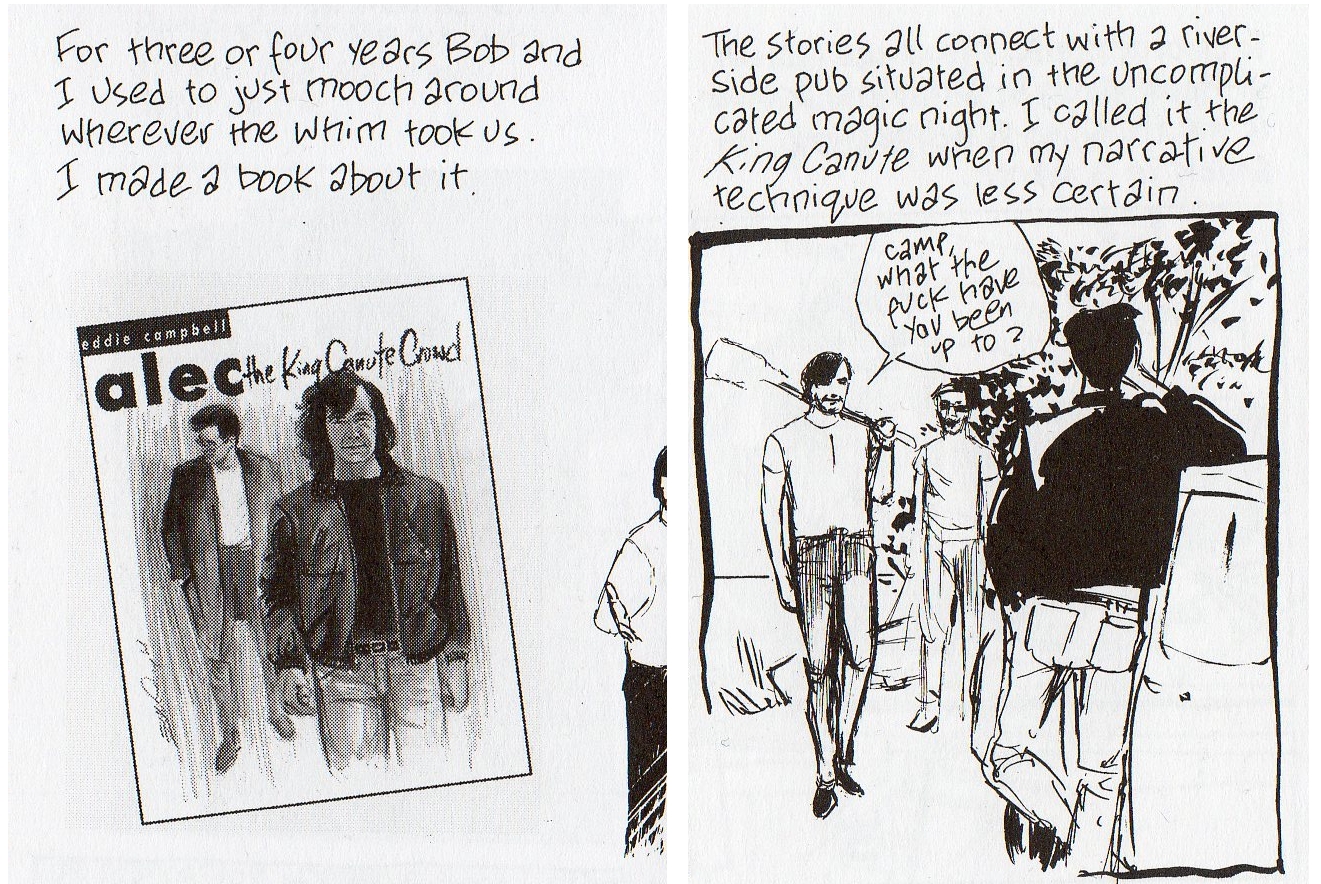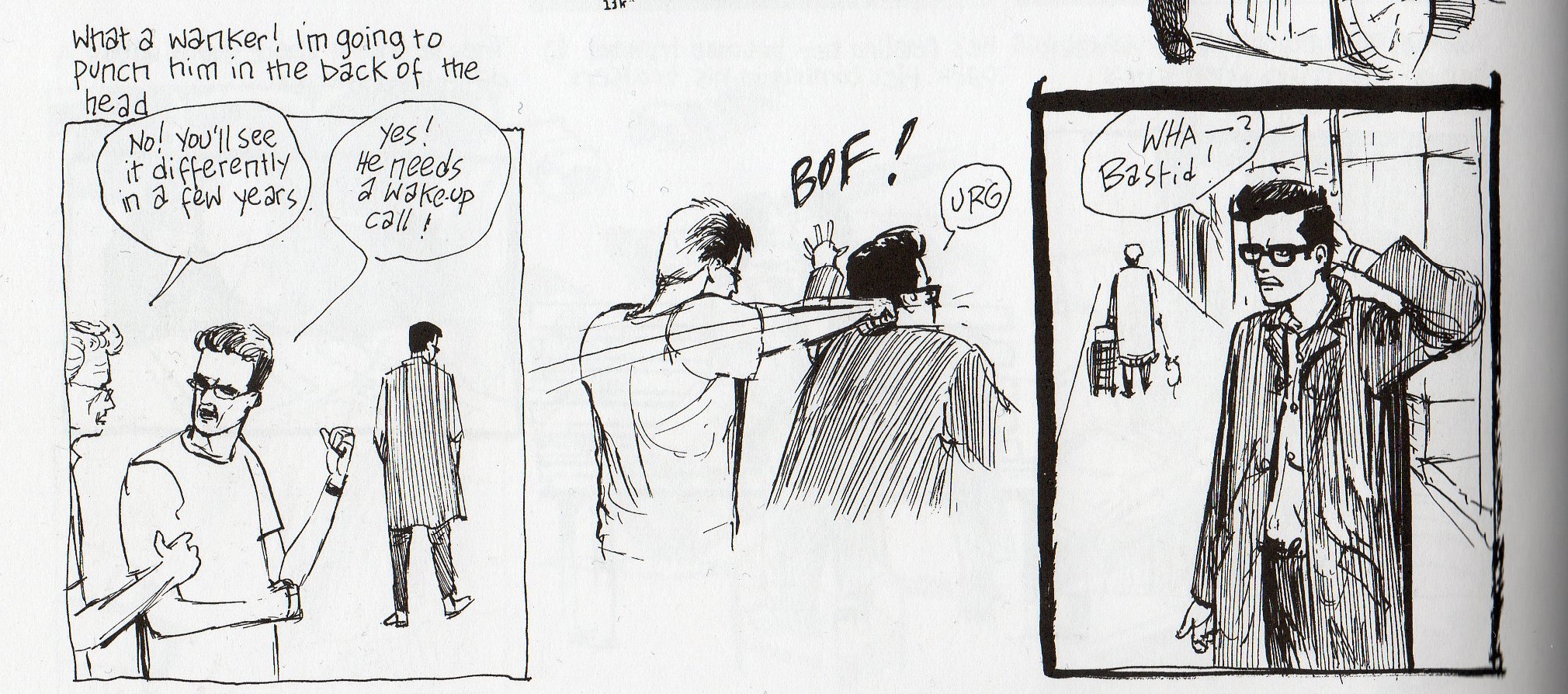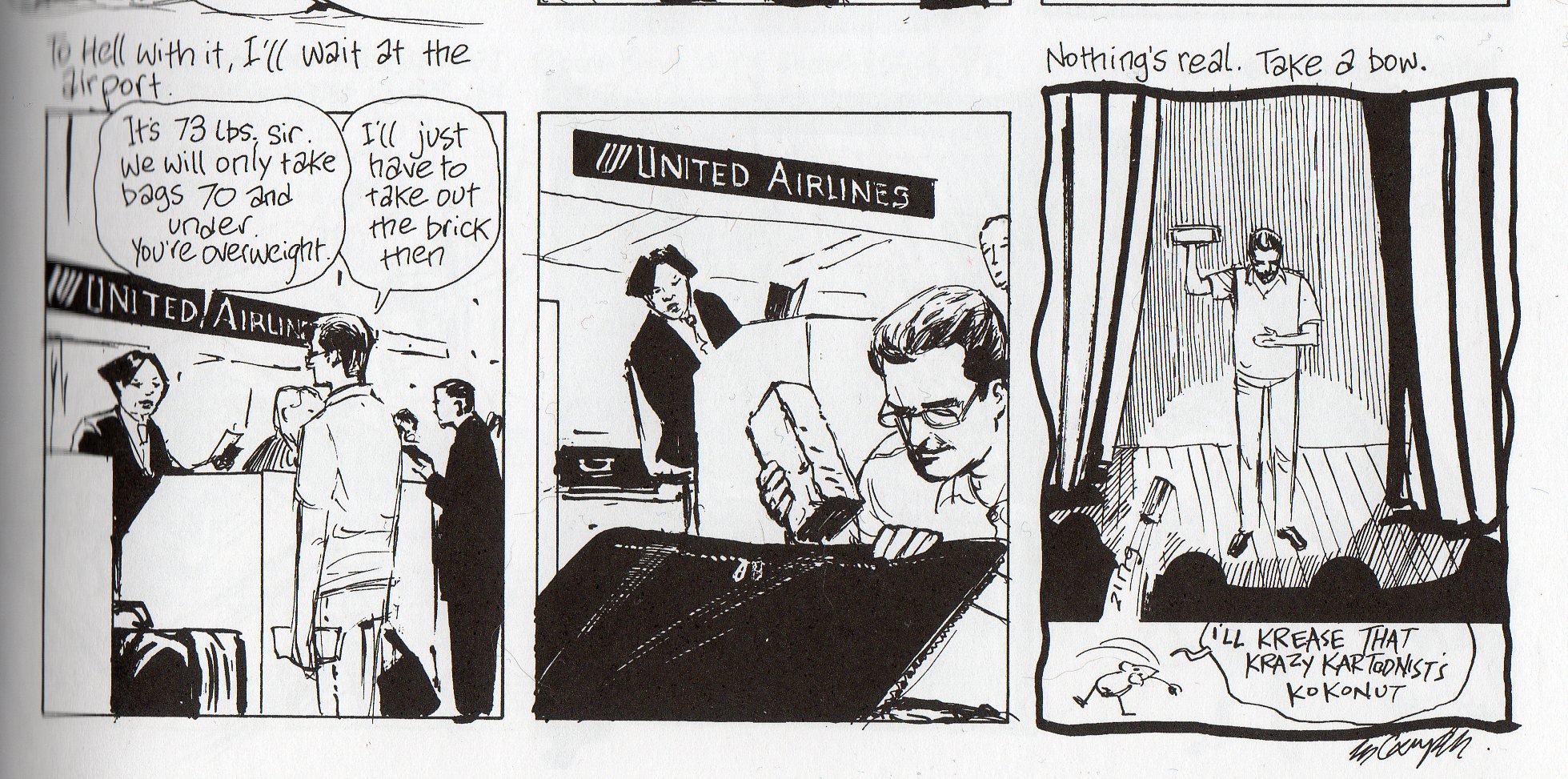Forgive me if this seems a little dashed off. I joined the roundtable late and have worked this up fairly quickly. I’ll stick around in the comments to flesh out or fight on any points not fully explored in the blog post proper.
As Noah has teased a bit, I come here not to bury Campbell but to praise him. I’m a hugely enthusiastic fan of the material collected in The Years Have Pants, and particularly of the book After The Snooter, the second most recent round-up of Campbell’s autobiographical comics. I believe Robert Stanley Martin, in his otherwise fine essay on The Fate of The Artist yesterday, referred to After The Snooter as a minor work in the Campbell ouevre. You’re going to hell for that, Robert, but it’s okay. We all make mistakes.
Part of my affection for Campbell’s work is a share of common interests: observational humorous anecdotes, the creative life, wine, the alternate usefulness and folly of self-mythologizing, Alan Moore’s basement — all of these are subjects I come preprogrammed to enjoy. Where others’ mileage varies on these particulars, there’s no accounting for taste, I suppose.
Having read all the old stuff collected in The Years Have Pants before, it’s an odd experience to see it all laid out in one big book. I’m actually not terribly fond of the omnibus format. I prefer to engage with the books as shorter, discrete units. Still, the massive collection redounds to the benefit of my favorite Alec book, After The Snooter. Snooter is the first book in which Campbell drops the Alec conceit, and calls himself by his own name — so it is essentially the first Alec book that is not an Alec book. By collecting them all together, Snooter becomes a turning point in the larger narrative — Alec shifts to Eddie, and Eddie’s narrative becomes smoother, more assured, more seemingly simple. As Campbell relaxes the Alec moniker, so does his entire style relax. I would argue that without this transition in Campbell’s outlook, Robert Stanley Martin’s precious The Fate of The Artist becomes an impossibility. Renounce, Robert Stanley Martin, renounce and accept The Snooter into your soul! It comes for us all, one day, anyway.
Campbell writes in his interim note at the beginning of the Snooter section of the book that unlike previous books which he conceived of and produced in a chronological fashion, the bits in After the Snooter were produced in fits and bursts, published as individual short pieces in various places as they were finished, and collected and re-ordered non-chronologically to make up the book. I think this process shows in the end result, not in Snooter seeming disjointed, but in that Snooter lacks the very present feeling of EFFORT that Campbell’s previous books carry with them. In The King Canute Crowd especially, but in the other Alec books too, you can really make out Campbell trying very hard to make something of worth. It very often works, and there are certainly passages I get caught up in, but for the most part I’m very aware of the author as an author in the early stuff. Ironically, once the author starts getting called by his own name, I lose sight of his heavy hand of creation. When Eddie is Alec, I’m constantly thinking about the fact that Alec is Eddie. When Eddie is Eddie, it’s a more natural experience — the comics function as Eddie Campbell very comfortably spinning a yarn rather than self-consciously crafting a fiction.
Certainly a part of it is that Eddie is older, and though he’s still prone to bouts of Scottish ill-temper, as an artist he’s more confident and laid back. The things he finds interesting now aren’t the snatches of poetry found in a bohemian glimpse of the world, but the embracing of the humor and delight to be found in the relentless absurdity of life. My favorite moment in all of Campbell’s work is on page 543, at the end of the “Millenium World Tour.” Pages earlier, Campbell is shown winning an Ignatz, the actual physical manifestation of which is a brick, after the brick Ignatz the mouse eternally throws at Krazy Kat in George Herriman’s seminal comic strip. On p. 543, Campbell is standing at the airport check-in counter, and is informed that his luggage is overweight. He sanguinely replies “I’ll just take out the brick, then,” and proceeds to do so, much to the surprise of the counter clerk. In the final panel, Campbell takes a bow on an imaginary stage as Ignatz the Mouse chucks a brick at him from the margins.
One of the most important things I learned in college was decidedly extracurricular. My roommate of several years had a real talent for finding ways to get astoundingly happy from little things. A cheap frozen pizza remembered in the freezer at exactly the right time, an odd rhythm in someone’s way of speaking, the aesthetics of a particularly empty street, a silly lyric in a rock song. He also had a knack for turning things into jokes or games at the drop of a hat, which is a type of self-mythologizing, or at least a type of storytelling — organizing the narrative information of your life to an entertaining purpose. It’s a way of looking at the world, and finding the humor that’s already there, and either appreciating it or emphasizing it. Learning to emulate that worldview — to become inordinately happy or amused at seemingly trivial, normally unobserved or ignored aspects of life — has been one of the most significant changes I have ever imposed on my own psychological well-being.
When you’re young and in college, it’s easy to create humor or drama by amping up your own hedonism. As you get older, that tends to be a less appealing option. Part of me certainly resonates with Campbell’s fuzzy idolizing of his days carousing around The King Canute, as I can remember the groggy romance of waking up on the floor of a sparsely furnished loft in Brooklyn, using my shoes as a pillow and my jacket for a blanket, and wandering out onto the roof to smell the cold morning air and receive the light of the sun that seemed, at the moment, to be of a different quality than the light at any other point in time in the universe. Even at that time in my life, though, I resonated far stronger with older Campbell (I first read After The Snooter approximately around my 19th birthday) and I think a lot of it has to do with the attitudes I attempted to adopt from my roommate. Being prepared to work with and enjoy the inevitable oddities in life seems like a much more sustainable and ultimately enjoyable way of living than constantly creating your own feverish reverie. As Pasteur says, “Chance favors the prepared mind.” If you’re in the right frame of mind, you’ll know what to do with the brick when the time comes.
_______
Update by Noah: The entire Eddie Campbell roundtable is here.




Thanks for writing this on short notice, Jason.
I hate the brick incident!
I do like the way you describe the shift from mythologizing hedonism to mythologizing the trivial, and the way it all fits into narrativizing his own life (or a version thereof.) It sort of fits in with Caro’s post…that is, the process is about narrativizing specifically, which perhaps explains/jibes with the emphasis on prose.
Man! You hate *everything* in the Alec mammoth brick book! I understand you perfectly: hating a two pager is one thing, hating a 639 pager is another completely different animal (mentally insert stupid smiley, please).
I think I have led a full life now that I’ve had Domingos mentally insert a stupid smiley at me.
I didn’t hate everything. I did hate most things though. The roundtable for me has been a lot of people referencing one bit or another of the book and me thinking, “Oh, yeah! That part! I hated that!”
Yeah, it’s always interesting — I’m all for discussing reasons and theories behind reactions to pieces of art, but there’s always a level at which “If you don’t get it, you don’t get it.” Which is not to mean you don’t “get” the brick incident or Campbell’s work intellectually, but that whatever resonance that is there for me and others just isn’t. I’m never sure how to approach such differences critically, or if it’s all that worthwhile to do so.
I think it’s often worthwhile to do so. I could explain fairly clearly why I don’t like the brick…but I’m trying not to antagonize everyone.
What’s interesting to me, though, is that (a) the defenses of the book actually confirm me in my dislike, and (b) I have a better understanding of the book and of my reaction to it, even though that reaction isn’t really altered. For example, I felt strongly that there was a connection between the early hedonism and the latter familial humor, but hadn’t really known quite how to express it. I think you explain it quite effectively.
Jason–
You’re not the only one to upbraid me for my indifference to “After the Snooter.” Matthias Wivel did, too, as did Craig Fischer in an e-mail. At one point in your piece, though, you really put your finger on why when you write, “As Campbell relaxes the Alec moniker, so does his entire style relax.” My problem is that he seems to become so relaxed that his work loses its urgency. He tries to get the tension going again in the sections with the Snooter and William Gull figures, but it strikes me as more willed than felt. He seems just a bit too content for autobio material to work for him.
A lot of how he gets his autobio oomph back with The Fate of the Artist is that we’re ostensibly seeing him through his wife’s and daughter’s eyes. Those perspectives are colored by their conflicts with him, and it makes for a much more bracing read.
The visual and narrative style of the book is also new for him and a lot more interesting for the reader. As I noted in my piece, this is also true of “Graffiti Kitchen” and “How To Be an Artist.” With “After the Snooter,” he just falls back on his baseline cartooning style. I beginning to think that a really good way to separate the wheat from the chaff with Campbell’s autobio material is to look at the art. If the style doesn’t constitute a significant break with his previous efforts, it doesn’t seem to be worth bothering with. (Oh, you’re going to condemn me to hell again.) The more urgency the material appears to have for him, the more inclined he is to strike out in a new direction with his visual approach.
I don’t actively dislike “After the Snooter,” by the way. I just don’t find it very interesting.
Make that “you really put your finger on why I don’t care for it when you write…”
An edit function is in the works, yes? Pretty please?
Edit function turned out to be harder than we’d hoped, unfortunately….
And now I feel like I’m being cowardly about the brick.
So briefly…I’m not really fond of anecdotes where the point is the narrator’s cleverness/freedom from convention. I could imagine that airport story as something Richard Feynman would tell…which is not a compliment.
Well Noah, it isn’t exactly freedom from convention, it’s a comment on alternative comics’ complete divorce from the mainstream of culture. Imagine Eddie taking out an Oscar. The reaction would be very different, methinks.
Great point about the drawing, Robert!…
Domingos…that just makes it worse. Then it’s not only preening idiosyncrasy, it’s also self-pity.
The latter, at least, I don’t think so. It doesn’t show, but I imagine him slightly bemused.
Ah, well, I don’t need to push it further. This may be the first time I’ve disliked something you’ve championed, Domingos, which is a nice switch.
Maybe I should add then that this is the kind of anecdote that I find completely irrelevant in Eddie Campbell’s oeuvre. Ditto the domestic comedy. it reminds me of tons of innocuous newspaper strips. The kind that newspaper editors, bless their souls, love so much because they offend no one and everyone loves a cute baby saying cute things, etc…
I also think that _Graffiti Kitchen_ is a completely different animal, that’s all…
Robert,
“My problem is that he seems to become so relaxed that his work loses its urgency.”
It may lose urgency but to my mind it gains a sort of sumptuousness. I don’t think the strips in “After the Snooter” are less complex or interesting than past strips, I think they just feel smoother because of Campbell’s more sure hand and mind.
I also don’t think I agree that there isn’t innovation or difference in the artistic style of “After The Snooter” — when I think of the book I think of a more fully rendered, shadowy, naturalistic imagery than other Alec books, which fits with my adjective of “sumptuous”. I’ll need to go look more carefully at some comparisons to be sure, as well. Wasn’t “Snooter” done during the time that Campbell was working closely with an assistant? I could be wrong about that…
Noah,
I don’t get a smug iconoclastic or self-pitying feel from the brick incident AT ALL. To me that moment is almost one of enlightenment. The thought is, “Oh, well, of course this is what I should do.” It’s a feeling of being in sync with the universe through acceptance of small, absurd moments like that one. I truly do not think Campbell believes himself to be showing anyone up in that anecdote, but maybe I’m wrong.
Regarding the brick, and maybe this is so obvious that I’m a drip for mentioning it, but it’s a common joke to accuse heavy luggage of containing a brick. The airport personnel are surprised that Mr. Campbell’s luggage actually does. The signifier “brick” switches back and forth between (at least) two frames of reference several times in these few panels.
Jason
Eddie was working with Pete Mullins during the period that Snooter was produced, but not on the Alec material. In fact he’s never collaborated with anyone on his autobiographical material.
Daren,
Thank you, that’s very helpful information!
I wonder then if what I’m seeing in the artwork of Snooter is (a) a coincidental shift in Campbell’s art, (b) a side effect of the process of working with an assistant in a faux-shop atmosphere, (c) all in my head.
Most things are usually (c).
Having accepted an Ignatz Award for Eddie Campbell (for this book!) I can testify to the fact that it is literally just a brick. I think the stand that it comes with might have a nice “Ignatz Award” engraving, but to me, the humor in the brick scene comes from the fact that this “prestigious” award is really almost worthless, and it’s absurd for him to pack it for an intercontinental flight when he could just replace it with any old brick when he gets home. That on top of the “whaddaya got in there, bricks?” physical comedy.
On behalf of the SPX clean-up committee, all Ignatz recipients wishing to recycle your brick, please leave it in the box addressed to Leigh Walton behind the registration desk and not on the back of the toilet in your hotel room. We have enough explaining to do.
Not really sure what Caro is getting at there… anyway, upon rereading my comment I realize it may seem dismissive or ungrateful. I should clarify that I personally love SPX and the Ignatz Awards, and was genuinely honored to participate on Eddie’s behalf. The plainness of the brick is part of the charm.
I was just gonna send them to you when everybody started giving ’em back to us in response to the power of your suggestion, ’cause I sure don’t wanna have to store ’em in my basement! :)
Caro, I for one got the joke the first time.
Jason, Ignatz wasn’t ‘chucking the brick from the margins’. He’s under the floorboards, like you see in The Family Upstairs in all those old comics histories, but not in my house. I hope.